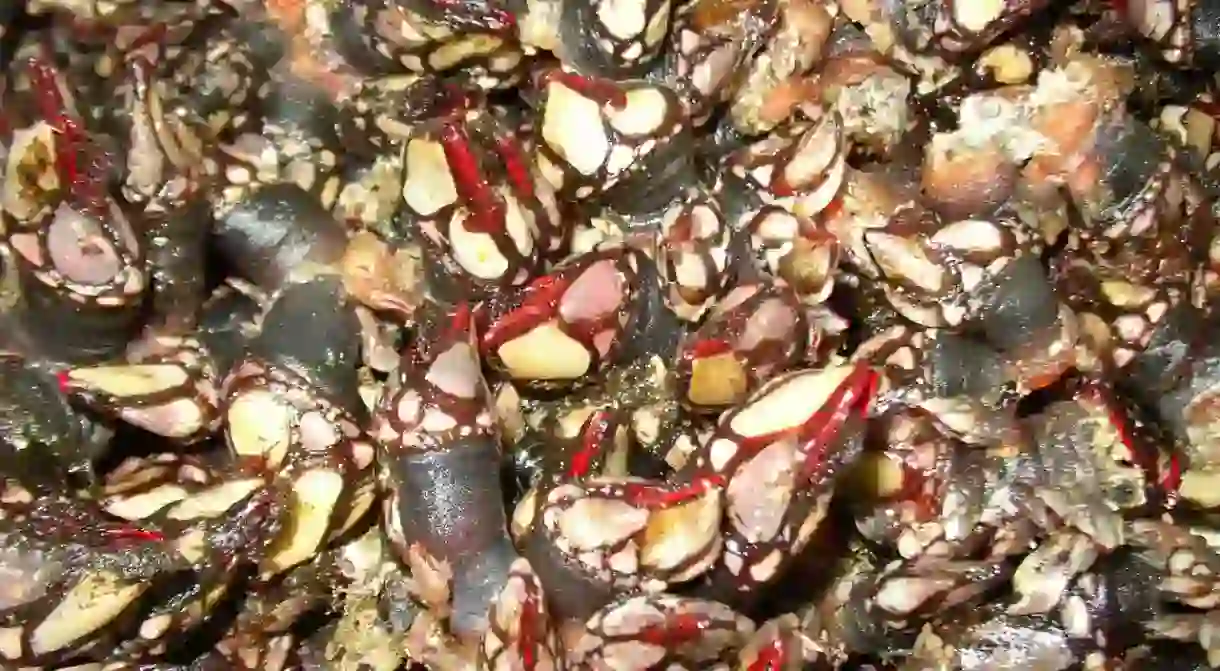12 Unusual Foods You Can't Leave Spain Without Trying

You’ve probably heard of Spain’s most typical foods, such as paella, seafood platters and patatas bravas (fried potato squares with a spicy tomato sauce), but there are many more unusual dishes that are very common here. From bull’s testicles to goose barnacles and fried breadcrumbs, here are 12 unusual foods you can’t leave Spain without trying.
Percebes
Percebes are the Spanish name for goose barnacles, and like other barnacles, they are filter-feeding crustaceans. They live in deep water and are found in oceans all over the world, although in most countries, people don’t eat them. In Spain, however, they are considered a delicacy, particularly in the Basque Country and Galicia, where they are boiled for a few minutes in seawater. They are expensive, so are eaten as a luxury item.

Manitas de cerdo
The Spanish eat every single part of an animal, and that includes the feet, so pig’s trotters are not an uncommon item to see on a menu here. In the past, the unwanted parts of the pig or cow were given to the poor people whose job it was to kill them, as a type of payment, so they had to become very creative at finding ways of cooking them. In Andalusia, pig’s trotters are often boiled and flavoured with garlic, bay leaves, saffron and peppercorns, while in Catalunya, you may see stuffed pig’s trotters on the menu.

Angulas
Angulas are baby eels that are around two or three years old. They measure around eight centimetres (three inches) long and are about twice as thick as a noodle. They are usually eaten on their own, rather than part of a dish, and are typically sautéed with oil and herbs, garlic, dried chilli peppers and white wine. Like goose barnacles, they are particularly expensive and are mostly eaten in the Basque Country.

Morcilla
British people will know morcilla as black pudding, but for everyone else, it’s congealed pig’s blood, made into a type of sausage. Sometimes rice is added to make a more hearty and filling sausage. Morcilla is eaten all over Spain, but it originated from the region of Castilla y León. One of the best types is morcilla de burgos, which is spiced with cumin and hails from the city of Burgos.

Caracoles
Caracoles are snails, and they are eaten in Spain as well as in France, particularly in the region of Catalunya. There are various ways of cooking them, but one of the most popular ways is a la llauna, where they are baked with garlic, oil, paprika and cognac. Other versions may use tomato sauce, white wine vinegar or whisky, depending on the region.

Migas
Fried breadcrumbs or fried flour may seem an odd sort of meal, but in the south of Spain it’s one of many people’s favourite dishes. The breadcrumbs or flour are fried along with garlic, pieces of green bell pepper and pieces of chorizo (spiced sausage).

Rabo de toro
Remember we told you that every single part of the animal is eaten in Spain? Yes, that means the tails too. Bull’s tail stew is a popular dish in Andalusia, particularly in Córdoba, where it is said to have originated. You can find it in other regions too, though, typically in restaurants close to bullrings. The bull’s tail is braised and then cooked with ingredients such as onions, peppers, tomatoes, red wine, garlic, and other herbs and spices.

Criadillas
And from the bull’s tails to its testicles – even these are not wasted. Criadillas are most commonly dipped in egg before being wrapped in breadcrumbs and deep-fried.

Oreja a la plancha
From trotters and tails to balls, and now to ears. Grilled pig’s ears are another common food to try in Spain. First they are boiled with herbs such as laurel leaves, pepper and garlic, then they are marinated in spices including cumin and paprika, before being fried until they are nice and crispy.

Ortiguillas fritas
Fried sea anemones are another unusual Spanish delicacy that isn’t very common in other countries. They anemones are typically deep-fried in breadcrumbs and have a squidgy texture and a fishy flavour, much as you’d imagine them to taste.

Calçots
The only vegetarian item on our list, calçots are perhaps not very scary, compared with some of these other foods. A cross between a spring onion and a sweet leek, calçots themselves are not unusual, but the way they are eaten is. They are grilled over an open fire and eaten whole, not used as an ingredient in dishes. Calçots are best eaten dipped in romesco sauce made from crushed almonds, red peppers, olive oil and garlic.

Kokotxas
Eating fish is not really unusual at all, but perhaps eating just the fish’s cheek is. Kokotxas are essentially just that: cod or hake cheeks cooked to perfection. You’ll find this on many menus, particularly in the Basque Country.

Which are Europe’s most fashionable neighbourhoods?













